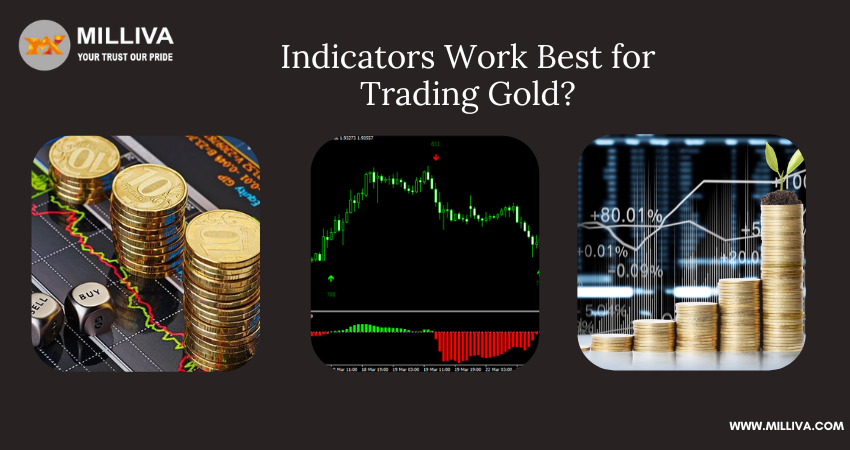What are Best Indicators for Trading Gold?

![]()
Investors develop a passion for the yellow metal with every economic downturn, inflationary atmosphere, or global event, whether it be physical bullion or mining equities. Professional investors utilise a trading strategy to invest in the gold market and choose the finest gold trading brokers, just like they do with any other asset class. Here we will discuss few of the Best Indicators for Trading Gold
Technical analysis of gold is important when purchasing and selling the precious metal. Therefore, what kinds of indicators and signals should you watch out for throughout each session?
Let’s illuminate this asset like it’s gold.
Why Trade Gold, You Ask?
Should you even hold gold in a world that is in need of yield?
Financial analysts have differing opinions, however it is commonly advised that precious metals should make up roughly 10% of your whole portfolio.
In times of turmoil and anarchy, whether they be in the international financial markets or the rest of the world, investors can rely on the safety and security of gold.
Although a rising dollar could theoretically affect goods made of metals valued in dollars, gold’s attraction lies in its intrinsic value. It is a vital part of cars and computers and has numerous other purposes in addition to being a tool for investors.
Utilizing the Gold Forward Offer Rate would allow you to earn a dividend while still owning gold (GOFO). This is the interest swap rate for a trade of gold for dollars.
Best Indications For Gold Trading
There are many indicators that can be used to forecast changes in gold’s price. Find some of the top gold trading indicators below.

Relative Strength Indicator (RSI)
One of the most widely used technical indicators by traders is the Relative Strength Indicator (RSI). Knowing whether a trading instrument, in this case gold, is overbought or oversold is a useful tool.
We would claim that the RSI has entered oversold territory if it falls below 30. On the other side, overbought conditions would be indicated by an RSI reading of 70 or above.
RSI is a fantastic tool for signal filtration. You might examine the RSI value, for instance, if you get a purchase signal. If it is higher than 70, you might want to think again about buying gold because the market is already overbought. It would be best if the number was around 70.
Although some trading opportunities will be lost, it may raise the overall calibre of the signals your trading technique is providing you. Find out more about the sophisticated RSI trading approach.
Moving Averages Indicator
Moving averages are straightforward but useful indicators for gold traders. They can be used to simply determine the market’s direction; for instance, by drawing a 200 MA on a daily chart.
They can also serve as indicators that produce indications for entry and exit. On the hourly chart, for instance, you may draw a fast-moving (10) and a slow-moving (20) MA. A purchase signal would be sent after the 10 MA crossed the 20 MA. Selling would be indicated if the 10 MA crossed below the 20 MA.
This is a condensed illustration. In order to filter out the undesirable signals, you will need to test out various parameters and add additional tools. Additionally, you must confirm that the price of gold is trending (either up or down). You will receive a lot of misleading signals if gold is consolidating in a range.
Bollinger Bands
Three lines known as Bollinger bands are used to depict volatility, or the price range that an asset has historically traded in.
The trading band is represented by the two outside lines, which indicate the upper and lower ranges of price movement that should be anticipated to trade 90% of the time. The middle line depicts the actual price action as it moves between these boundaries as it changes from day to day. When these bands contract (shrinken), gold is likely to be experiencing significant volatility; when these bands expand, gold may be going through a period of low volatility.
How do I Pick the Ideal Gold Trading Approach?
For trading gold, there is no trading method that can be deemed “the best.” For trader A, a particular technique can perform admirably, but poorly for trader B. The importance of trading psychology in the markets is one important component.
Discovering your trading style and creating a trading plan with risk management guidelines are advised before you begin building trading methods (e.g. how much you are willing to risk per trade).
You can begin creating a trading strategy once you’ve made up your mind about whether you want to trade for the long or short term, and if you want to use technical analysis, fundamental analysis, or both.
A demo account can be your best friend throughout the testing stage. You can use it to perform backtesting as well as real-time strategy testing without taking any risks. Although you can research the properties of gold and the factors influencing its price beforehand, you’ll have a better understanding of the market by watching the price movement and testing the technique in real time.
Which Trading Session for Gold is Ideal?
The spot contract’s symbol is XAU/USD, and trading hours are Monday at 1:00 AM through Friday at 23:58, with a break for trading every day from 23:59 to 1:00 AM. Time is expressed in MT4 server time.
The symbol “GOLD.fs” designates the location of the gold futures contract. Trading hours are from 18:01 on Sunday through 16:59 on Friday, with a break every day from 16:59 to 18:01. Because the underlying futures contract is traded in New York, all times are in Eastern Standard Time (GMT-4). In general, the London trading session and the early part of the New York trading day will have the most liquidity. Due to the lower spreads and greater number of trading chances than during the typically calmer Asian session, scalpers and intraday traders may prefer to trade gold during those sessions.

Visit us on: www.milliva.com





